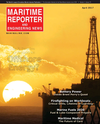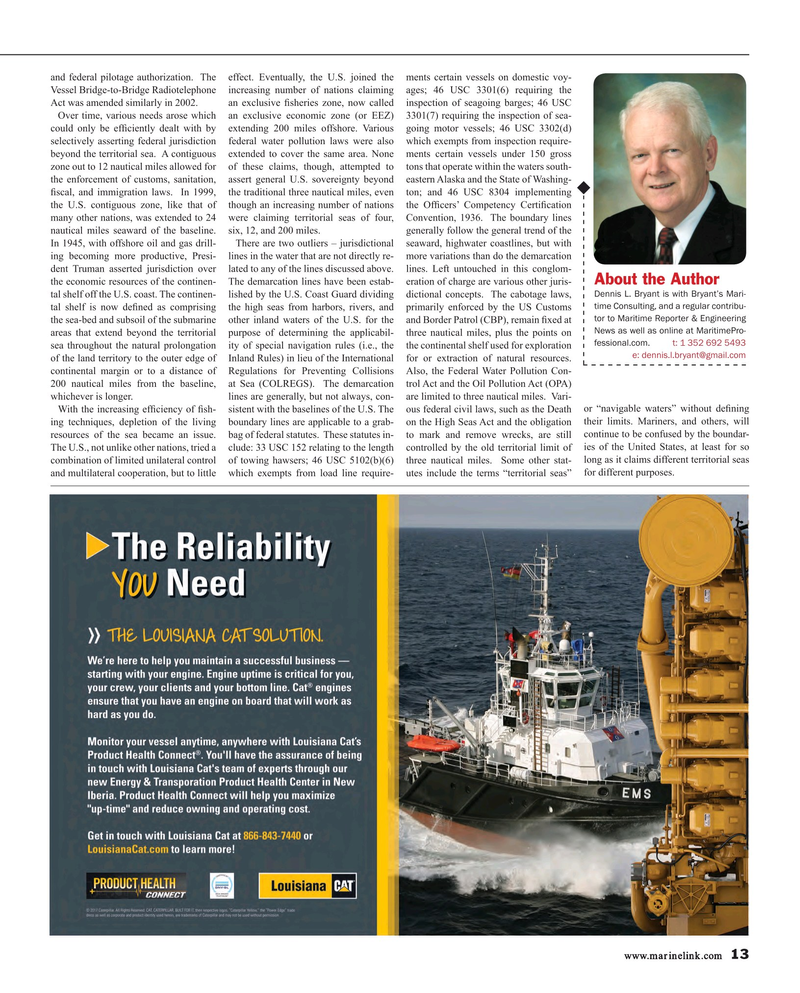
Page 13: of Maritime Reporter Magazine (April 2017)
The Offshore Annual
Read this page in Pdf, Flash or Html5 edition of April 2017 Maritime Reporter Magazine
and federal pilotage authorization. The effect. Eventually, the U.S. joined the ments certain vessels on domestic voy-
Vessel Bridge-to-Bridge Radiotelephone increasing number of nations claiming ages; 46 USC 3301(6) requiring the
Act was amended similarly in 2002. an exclusive ? sheries zone, now called inspection of seagoing barges; 46 USC
Over time, various needs arose which an exclusive economic zone (or EEZ) 3301(7) requiring the inspection of sea- could only be ef? ciently dealt with by extending 200 miles offshore. Various going motor vessels; 46 USC 3302(d) selectively asserting federal jurisdiction federal water pollution laws were also which exempts from inspection require- beyond the territorial sea. A contiguous extended to cover the same area. None ments certain vessels under 150 gross zone out to 12 nautical miles allowed for of these claims, though, attempted to tons that operate within the waters south- the enforcement of customs, sanitation, assert general U.S. sovereignty beyond eastern Alaska and the State of Washing- ? scal, and immigration laws. In 1999, the traditional three nautical miles, even ton; and 46 USC 8304 implementing the U.S. contiguous zone, like that of though an increasing number of nations the Of? cers’ Competency Certi? cation many other nations, was extended to 24 were claiming territorial seas of four, Convention, 1936. The boundary lines nautical miles seaward of the baseline. six, 12, and 200 miles. generally follow the general trend of the
In 1945, with offshore oil and gas drill- There are two outliers – jurisdictional seaward, highwater coastlines, but with ing becoming more productive, Presi- lines in the water that are not directly re- more variations than do the demarcation dent Truman asserted jurisdiction over lated to any of the lines discussed above. lines. Left untouched in this conglom-
About the Author the economic resources of the continen- The demarcation lines have been estab- eration of charge are various other juris-
Dennis L. Bryant is with Bryant’s Mari- tal shelf off the U.S. coast. The continen- lished by the U.S. Coast Guard dividing dictional concepts. The cabotage laws, time Consulting, and a regular contribu- tal shelf is now de? ned as comprising the high seas from harbors, rivers, and primarily enforced by the US Customs tor to Maritime Reporter & Engineering the sea-bed and subsoil of the submarine other inland waters of the U.S. for the and Border Patrol (CBP), remain ? xed at
News as well as online at MaritimePro- areas that extend beyond the territorial purpose of determining the applicabil- three nautical miles, plus the points on fessional.com. t: 1 352 692 5493 sea throughout the natural prolongation ity of special navigation rules (i.e., the the continental shelf used for exploration e: [email protected] of the land territory to the outer edge of Inland Rules) in lieu of the International for or extraction of natural resources. continental margin or to a distance of Regulations for Preventing Collisions Also, the Federal Water Pollution Con- 200 nautical miles from the baseline, at Sea (COLREGS). The demarcation trol Act and the Oil Pollution Act (OPA) whichever is longer. lines are generally, but not always, con- are limited to three nautical miles. Vari-
With the increasing ef? ciency of ? sh- sistent with the baselines of the U.S. The ous federal civil laws, such as the Death or “navigable waters” without de? ning ing techniques, depletion of the living boundary lines are applicable to a grab- on the High Seas Act and the obligation their limits. Mariners, and others, will resources of the sea became an issue. bag of federal statutes. These statutes in- to mark and remove wrecks, are still continue to be confused by the boundar-
The U.S., not unlike other nations, tried a clude: 33 USC 152 relating to the length controlled by the old territorial limit of ies of the United States, at least for so combination of limited unilateral control of towing hawsers; 46 USC 5102(b)(6) three nautical miles. Some other stat- long as it claims different territorial seas and multilateral cooperation, but to little which exempts from load line require- utes include the terms “territorial seas” for different purposes.
www.marinelink.com 13
MR #4 (10-17).indd 13 MR #4 (10-17).indd 13 4/5/2017 9:13:28 AM4/5/2017 9:13:28 AM

 12
12

 14
14
